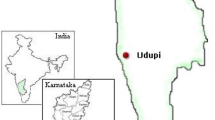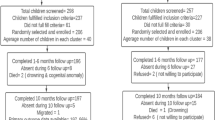Abstract
Cassava cyanide-related neurocognitive impairment may persist for years in Central African children who rely on cassava as a dietary staple. In the Democratic Republic of the Congo, a cassava processing method, the ‘wetting method’, reduced cyanide in cassava, prevented konzo, and proved a cost-effective intervention to improve children’s cognitive development. Scaling up use of the wetting method may help prevent neurocognitive impairment in millions of at-risk children in sub-Saharan Africa.
This is a preview of subscription content, access via your institution
Access options
Access Nature and 54 other Nature Portfolio journals
Get Nature+, our best-value online-access subscription
$29.99 / 30 days
cancel any time
Subscribe to this journal
Receive 12 digital issues and online access to articles
$119.00 per year
only $9.92 per issue
Buy this article
- Purchase on Springer Link
- Instant access to full article PDF
Prices may be subject to local taxes which are calculated during checkout

Similar content being viewed by others
Data availability
This work used data collected from a literature search which are listed in the Supplementary Information. All analyses are based on this collected dataset.
Code availability
The data were analysed with the statistical software R. The script can be made available upon request.
References
Zhang, P., Gruissem, W. in Transgenic Crops of the World (ed. Curtis, I. S.) 301–319 (Springer, 2004).
Nahrstedt, A. Cyanogenic compounds as protecting agents for organisms. Plant Syst. Evol. 150, 35–47 (1985).
Howlett, W. P., Brubaker, G. R., Mlingi, N. & Rosling, H. Konzo, an epidemic upper motor neuron disease studied in Tanzania. Brain 11, 223–235 (1990).
Siddiqi, O. K. et al. Konzo outbreak in the Western Province of Zambia. Neurology 94, e1495–e1501 (2020).
Banea, J. P. et al. Control of konzo in DRC using the wetting method on cassava flour. Food Chem. Toxicol. 50, 1517–1523 (2012).
Wu, F., Mitchell, N. J., Male, D. & Kensler, T. W. Reduced foodborne toxin exposure is a benefit of improving dietary diversity. Toxicol. Sci. 141, 329–334 (2014).
Boivin, M. J. et al. Neuropsychological effects of konzo: a neuromotor disease associated with poorly processed cassava. Pediatrics 131, 1231–1239 (2013).
Boivin, M. J. et al. Cognitive and motor performance in Congolese children with konzo during 4 years of follow-up: a longitudinal analysis. Lancet Glob. Health 5, e936–e947 (2017).
Montagnac, J. A., Davis, C. R. & Tanumihardjo, S. A. Processing techniques to reduce toxicity and antinutrients of cassava for use as a staple food. Compr. Rev. Food Sci. F 8, 17–27 (2009).
Burns, A. E., Gleadow, R. M., Cliff, J., Zacarias, A. & Cavagnaro, T. R. Cassava: the drought, war and famine crop in a changing world. Sustainability 2, 3572–360 (2010).
Banea, J. P. et al. Effectiveness of wetting method for control of konzo and reduction of cyanide poisoning by removal of cyanogens from cassava flour. Food Nutr. Bull. 35, 28–32 (2014).
Banea, J. P. et al. Control of konzo by detoxification of cassava flour in three villages in the Democratic Republic of Congo. Food Chem. Toxicol. 60, 506–513 (2013).
Kashala-Abotnes, E. et al. Dietary cyanogen exposure and early child neurodevelopment: an observational study from the Democratic Republic of Congo. PLoS ONE 13, e0193261 (2018).
Banea, J. P. et al. Konzo prevention in six villages in the DRC and the dependence of konzo prevalence on cyanide intake and malnutrition. Toxicol. Rep. 2, 609–616 (2015).
Bradbury, J. H., Cliff, J. & Denton, I. C. Uptake of wetting method in Africa to reduce cyanide poisoning and konzo from cassava. Food Chem. Toxicol. 49, 539–542 (2011).
Sachs, J. D. Macroeconomics and Health: Investing in Health for Economic Development (World Health Organization, 2001).
Woods, B., Revill, P., Sculpher, M. & Claxton, K. Country-level cost-effectiveness thresholds: initial estimates and the need for further research. Value Health 19, 929–935 (2016).
Gross Domestic Product (World Bank, 2019); https://data.worldbank.org/indicator/NY.GDP.MKTP.CD
WHO Estimates of the Global Burden of Foodborne Diseases: Foodborne Diseases Burden Epidemiology Reference Group 2007–2015 (World Health Organization, 2015).
Wu, F. & Khlangwiset, P. Evaluating the technical feasibility of aflatoxin risk reduction strategies in Africa. Food Addit. Contam. 27, 658–676 (2010).
Mullen, E. M. Mullen Scales of Early Learning: AGS Edition (American Guidance Services, 1995).
Boivin, M. J. et al. Neurodevelopmental assessment at one year of age predicts neuropsychological performance at six years in a cohort of West African children. Child Neuropsychol. 27, 548–571 (2021).
Staples, K. L., MacDonald, M., Zimmer, C. in International Review of Research in Developmental, Disabilities Vol. 42 (ed. Hodapp, R. M.) 179–214 (Academic Press, 2012).
Carrington, C., Devleesschauwer, B., Gibb, H. J. & Bolger, P. M. Global burden of intellectual disability resulting from dietary exposure to lead, 2015. Environ. Res. 172, 420–429 (2019).
Bellinger, D. C., Devleesschauwer, B., O’Leary, K. & Gibb, H. J. Global burden of intellectual disability resulting from prenatal exposure to methylmercury, 2015. Environ. Res. 170, 416–421 (2019).
Diagnostic and Statistical Manual of Mental Disorders: DSM-IV 4th edn (American Psychiatric Association, 1994).
WHO Methods and Data Sources for Global Burden of Disease Estimates 2000–2015. Global Health Estimates Technical Paper (World Health Organization, 2017).
World Population Prospects. Data Booklet (ST/ESA/SER.A/424) (United Nations, Department of Economic and Social Affairs, Population Division, 2019).
Acknowledgements
This study was supported by Grand Challenges Canada Saving Brains Seed Grant 1809-18726 (M.J.B., E.K-A., F.W.), NIEHS/FIC grant R01ES01019841 (D.T-K., J.-P.B.M., D.M., M.J.B.) and USDA grant MICL02527 (F.W.). We dedicate this paper to our co-author Dr Jean-Pierre Banea Mayambu, who passed away on 13 September 2020. For over 30 years, Dr Banea was Director of the DRC’s National Nutrition Institute (PRONANUT). He was devoted to understanding and preventing konzo in the DRC and pioneered the wetting method in rural DRC to teach home caregivers how to treat cassava flour to reduce cyanide for improved food safety.
Author information
Authors and Affiliations
Contributions
C.C. and F.W. conceived the study. C.C., E.K.-A., J.-P.B.M., D.M.N., D.T.-K., D.M., M.K., M.J.B. and F.W. implemented the analysis. C.C., M.J.B. and F.W. contributed to data interpretation. C.C., D.T.-K., M.J.B. and F.W. drafted the paper, and all authors contributed to the writing.
Corresponding author
Ethics declarations
Competing interests
The authors declare no competing interests.
Additional information
Peer review information Nature Food thanks Phoebe Alitubeera and the other, anonymous, reviewer(s) for their contribution to the peer review of this work.
Publisher’s note Springer Nature remains neutral with regard to jurisdictional claims in published maps and institutional affiliations.
Supplementary information
Supplementary Information
Supplementary Fig. 1 and Table 1.
Rights and permissions
About this article
Cite this article
Chen, C., Kashala-Abotnes, E., Banea Mayambu, JP. et al. Cost-effectiveness of a wetting method intervention to reduce cassava cyanide-related cognitive impairment in children. Nat Food 2, 469–472 (2021). https://doi.org/10.1038/s43016-021-00321-w
Received:
Accepted:
Published:
Issue Date:
DOI: https://doi.org/10.1038/s43016-021-00321-w



